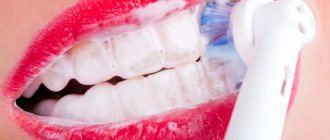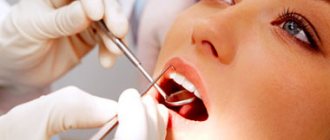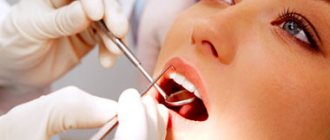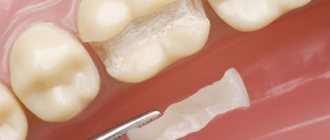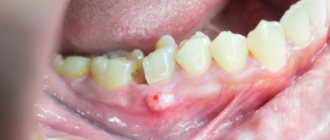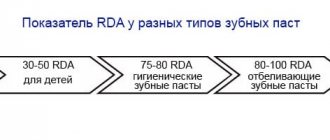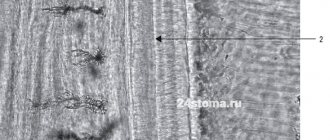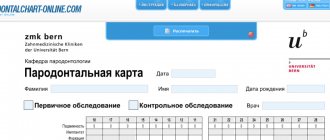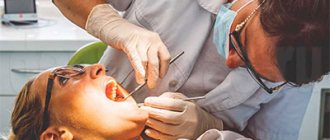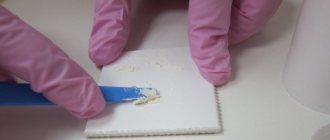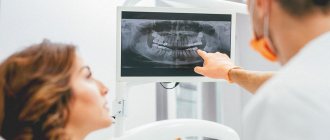Oral hygiene is one of the most accessible and at the same time one of the leading methods of preventing oral diseases. Regular and competent oral care is an integral part of all preventive measures. Mass population surveys conducted in all countries of the world have convincingly shown that systematic oral care has an undoubted preventive value. It is possible to objectively assess the level of oral hygiene only using hygiene indices.
To identify dental plaque in assessing oral hygiene in modern dentistry, objective indicators (indices) are used that characterize the quality and quantity of dental plaque. However, the number of assessment methods, which are based on different numbers of teeth from different functional groups, up to staining all teeth on both sides or collecting and weighing plaque around individual teeth, indicates the relevance of the problem under consideration and the imperfection of existing methods.
Oral hygiene indices.
Method for determining the Fedorov-Volodkina hygienic index // E.M. Melnichenko “Prevention of dental diseases”, Minsk, “Higher School”., 1990, pp. 3-17.
It is determined by the intensity of the color of the vestibular surface of the six lower frontal teeth by applying an iodine-iodide-potassium solution (Schiller-Pisarev liquid).
The calculation is carried out according to the formula:
Ksr (hygiene index) = Kn (total hygiene index for each of the six teeth) / n (number of teeth).
Coloring the entire surface of the crown is scored 5 points, 3/4 of the surface - 4, 1/2 of the surface - 3, 1/4 of the surface - 2 points. If there is no staining, 1 point is given. The indicator is assessed as follows: good index, satisfactory, unsatisfactory, bad, very bad.
However, the proposed method has a number of disadvantages:
— determination of the quality and quantity of dental plaque, assessment of the hygiene index was carried out only on one’s own teeth; — the use of known dyes is impossible when determining the amount of dental plaque on bridges, since these solutions are difficult to wash off from the surface of the dentures.
| Name | Facilities diagnostics | Self-control criteria |
| 1. Fedorov-Volodkina index | Lugol's solution 1.1-1.5 is good 1.6-2.0 - satisfactory 2.1-2.5 - unsatisfactory 2.6-3.4 - bad 3.5-5.0 - very bad | The vestibular surface of the six front teeth of the lower jaw - incisors and canines - is stained with Lugol's solution. Rating on a 5-point system: 5 points – the entire surface of the teeth is stained, 4 points – 3/4 of the tooth surface, 3 points - 1/2 of the tooth surface, 2 points - 1/4 of the tooth surface, 1 point - no staining Then find the arithmetic mean by dividing the sum of the color of all teeth by their number: K av = Kp: p. Good level of hygiene: Ksr=1.0-1.3 b IG = sum of points of six teeth 6. |
| 2. Green-Vermilion Index (1964) - universal hygiene index of the UIG | Schiller-Pisarev solution or Lugol's solution 0-0.6 good 0.7-1.6 satisfactory 1.7-2.5 unsatisfactory 2.6-3 - bad | Determine the presence of plaque and tartar on the buccal surface of the first upper molars, the lingual surface of the lower molars, and the vestibular surface 1| and lower |1 6 1| 6 6 | 1 6. On all surfaces, plaque is first determined, then tartar. 0 - no plaque (stone) 1 - plaque covers up to 1/3 of the tooth surface 2 - plaque covers from 1/3 to 2/3 of the tooth surface 3 – plaque covers more than 2/3 of the tooth surface Tartar assessment: 0 – absence of tartar 1 – supragingival tartar covers no more than 1/3 of the tooth crown 2 – supragingival tartar covers from 1/3 to 2/3 of the tooth crown, or single formations of subgingival tartar are detected 3 – supragingival tartar covers more than 2/3 of the tooth crown, or significant deposits of subgingival tartar are detected along the entire circumference of the tooth. SPI = sum of indicators of 6 teeth 6 The assessment of the tartar index is carried out similarly to UIG = IZN + IZK |
| 3. Index ONI-S | Schiller-Pisarev solution 0-no staining 1- staining up to 1/3 of the crown, 2- staining up to 2/3 of the crown 3- more than 2/3 of the tooth crown | Staining of the vestibular and lingual surfaces 6 1 | 6 6 | 1 6 The plaque index and stone index are summed up and the average is obtained. |
| RHP Index – Oral Hygiene Performance Index (Podshadley, Haley – 1968) | Color 6 teeth: 16, 26, 11, 31 – vestibular surfaces. 36, 46 – lingual surfaces | The examined surface is divided into 5 sections: 1-medial, 2-distal, 3-mid-occlusal, 4-central, 5-mid-cervical. Plaque is assessed at each site: 0 – no staining 1 – staining detected For each tooth, the site codes are summed up. Then the values of all examined teeth are summed up and the resulting sum is divided by the number of teeth. Index values: 0 - excellent 0.1-0.6 – good 0.7-1.6 – satisfactory 1.7 or more - unsatisfactory |
Classification of root furcation lesions
It is determined using a special curved Naber probe or a regular blunt probe. Furcation lesions are determined in both horizontal and vertical positions.
In the horizontal direction: I – a slight depression is visible in the mucous membrane on the buccal surface, but the probe does not enter the area of depression or penetrates the defect to a depth of 1-2 mm. II – the probe enters the bifurcation by more than 1-2 mm, but the connection between one furcation and another is not determined III – the place of the furcation is visible, with the help of the probe you can pass from one furcation to another.
In the vertical direction (Tarnow, Fletcher, 1984): 1 – vertical loss of bone from 1 to 3 mm; 2 - vertical loss of bone in the furcation area up to 4-6 mm; 3 - vertical loss of bone 7 mm. and more.
Index of need for periodontal disease treatment - CPITN
To assess the prevalence and intensity of periodontal diseases, almost all countries use the index of need for the treatment of periodontal diseases - CPITN . This index was proposed by specialists of the WHO working group to assess the condition of periodontal tissues during epidemiological surveys of the population.
Currently, the scope of the index has expanded, and it is used to plan and evaluate the effectiveness of prevention programs, as well as calculate the required number of dental personnel. In addition, the CPITN index is currently used in clinical practice to examine and monitor the periodontal condition of individual patients.
In this regard, the CPITN index can be considered a screening test at both the population and individual levels.
This index registers only those clinical signs that may undergo reverse development: inflammatory changes in the gums, which are judged by bleeding, tartar. The index does not record irreversible changes (gingival recession, tooth mobility, loss of epithelial attachment), does not indicate the activity of the process and cannot be used to plan specific clinical treatment in patients with developed periodontitis.
The main advantages of the CPITN index are the simplicity and speed of its determination, information content and the ability to compare results.
To determine the CPITN index, the dentition is conventionally divided into 6 parts (sextants), including the following teeth: 17/16, 11, 26/27, 36/37, 31, 46/47.
The periodontium is examined in each sextant, and for epidemiological purposes only in the area of the so-called “index” teeth. When using the index for clinical practice, the periodontium is examined in the area of all teeth and the most severe lesion is identified.
It should be remembered that a sextant is examined if it contains two or more teeth that cannot be removed. If only one tooth remains in the sextant, it is included in the adjacent sextant, and this sextant is excluded from the examination.
In the adult population, starting from 20 years of age and older, 10 index teeth are examined, which are identified as the most informative:
When examining each pair of molars, only one code characterizing the worst condition is taken into account and recorded.
For persons under 20 years of age, 6 index teeth are examined during the epidemiological survey: 16, 11, 26, 36, 31, 46.
CODE 1: bleeding observed during or after probing.
Note: bleeding may appear immediately or after 10-30 seconds. after probing.
CODE 2: tartar or other plaque-retaining factors (overhanging edges of fillings, etc.) are visible or felt during probing.
CODE 3: pathological pocket 4 or 5 mm (the edge of the gum is in the black area of the probe or the 3.5 mm mark is hidden).
CODE 4: pathological pocket 6 mm deep or more (with the 5.5 mm mark or black area of the probe hidden in the pocket).
CODE X: When only one or no teeth are present in the sextant (third molars are excluded unless they are in place of second molars).
To determine the need for periodontal disease treatment, population groups or individual patients can be categorized based on the following criteria.
0: CODE 0 (healthy) or X (excluded) for all 6 sextants means that there is no need for treatment for this patient.
1: A CODE of 1 or higher indicates that this patient needs to improve his oral hygiene status.
2: a) CODE 2 or higher indicates the need for professional hygiene and the elimination of factors that contribute to plaque retention. In addition, the patient needs training in oral hygiene.
b) CODE 3 indicates the need for oral hygiene and curettage, which usually reduces inflammation and reduces pocket depth to values equal to or less than 3 mm.
3: Sextant with CODE 4 can sometimes be successfully treated with deep curettage and adequate oral hygiene. In other cases, this treatment does not help, and then complex treatment is required, which includes deep curettage.
The prevalence and intensity of periodontal disease in the population is assessed based on the results of a survey of 15-year-old adolescents.
Prevalence of signs of periodontal damage (adolescents 15 years old)
Prevalence Bleeding gums Tartar
low 0 – 50% 0 – 20%
average 51 – 80% 21 – 50%
high 81 – 100% 51 – 100%
Level of intensity of signs of periodontal damage (adolescents 15 years old)
INTENSITY LEVEL BLEEDING GUMS CALCULUS
LOW 0.0 - 0.5 sextants 0.0 - 1.5 sextants
AVERAGE 0.6 - 1.5 sextants 1.6 - 2.5 sextants
HIGH < 1.6 sextants < 2.6 sextants
General overview
In dentistry, indices are a quantitative reflection of the progress of the pathological process that has developed in the periodontium.
When compared with clinical diagnostic methods, index assessment is considered relative, since it does not reflect the absolute accuracy of the ongoing process.
But periodontal indexing has some advantages that distinguish it from clinical diagnosis. With its help you can:
- measure the dynamics of tissue infection;
- monitor the spread and development of periodontal diseases;
- monitor the progress of treatment;
- evaluate its success and the results of preventive measures;
- perform epidemiological screening of the population;
- make comparisons of the results of different studies.
There are several dozen assessment indices for studying the condition of periodontium. All of them are divided into 3 groups:
- Reversible . With their help, the dynamics of diseases and the effectiveness of treatment are assessed. Reflect the severity of the inflammatory process, bleeding gums, loose teeth, the size of periodontal and gum pockets.
- Irreversible. They convey the manifestation of such signs as resorption (absorption) of bone tissue in the alveolar process, amyotrophy of the gums.
- Complex. They help to give a comprehensive description of the condition of periodontal tissues, taking into account the existing symptoms and the degree of development of pathological processes.
During one appointment, the dentist may perform several screenings to provide an accurate assessment of tissue health. But all of them, according to doctors, do not provide an individual approach to the patient and cannot completely replace a clinical examination.
What is the Dental Oral Health Index?
The hygiene index is indicators reflecting oral hygiene, the degree of contamination, determining the presence of signs of bacterial infection, indicating the number of teeth that are affected by caries.
The hygiene index allows a specialist to determine the reasons why tooth decay occurs, gum disease occurs, and also prescribe effective preventive measures.
With their help they determine:
- The level of dental health of the patient;
- The severity and stage of caries;
- Number of teeth pulled out;
- Quality of hygiene procedures;
- Presence of malocclusion;
- The degree of effectiveness of therapy.
Important to remember! Each diagnostic criterion for different types of lesions is reflected in an individual index.
Why are hygiene indices needed in dentistry?
The simplest and at the same time effective method of preventing dental diseases is careful adherence to hygiene standards. It is with its help that it is possible to prevent inflammatory and destructive processes in periodontal structures.
During an examination of the patient’s oral cavity, the dentist assigns a hygiene index, which depends on the following criteria:
- quality of teeth cleaning
- oral health
- number of missing teeth, as well as crowns that cannot be restored
- stage of bone tissue destruction
- inflammatory processes and the degree of their neglect
- presence of changes in bite
Hygiene indices in dentistry are used to monitor the effectiveness of treatment. After therapeutic procedures, the indicator should change for the better, which is necessarily recorded in the medical history.
There are different types of hygiene indices, which depend on the parameters being analyzed. In this way, it is possible to note important criteria characteristic of a particular dental disease.
Periodontal index system in general
The following types of periodontal indices in dentistry are distinguished:
- IGs are hygiene indices; they assess enamel contamination and the presence of tartar.
- II - inflammation indices - evaluates inflammatory pathology of the gums, periodontitis and periodontal disease.
- BDI – bone destruction index; combined indices.
All indices are not complicated and do not require special equipment; they are easy to identify. There are a lot of them, the main ones will be discussed below.
What are the subdivisions of indexes?
Periodontal indices are distinguished by reversibility, i.e. subject to regression and not subject to, as well as complex.
Reversible – monitor the dynamics of the pathological process and the effectiveness of treatment. These indices are aimed at the current symptoms of pathologies in their acute period:
- bleeding and inflammation of the gums;
- loose teeth;
- pockets of inflammation – gingival and periodontal.
The most frequently used of these periodontal indices are papillary-alveolar, PI, IG - hygiene indices, of which there are generally more than 15 (Schiller-Pisarev, Pakhomov, Ramfjord, etc.). The data of these indices may change, but the problems respond well to treatment and have a good prognosis, i.e. reversible.
Irreversible indices: gingival recession, X-ray, etc. Irreversible processes are already recorded here when it comes to the consequences and complications of pathologies, such as resorption (resorption) of the bone component of the alveolar processes, recession or amyotrophy of the gums. Treatment is ineffective.
Complex periodontal indices provide a comprehensive assessment of periodontal health. For example, the Komrke index includes a large number of studies: PM index, depth of gum pockets, degree of tissue atrophy, bleeding gums, degree of loose teeth (indicates the degree of inflammation).
Gingivitis index PMA (Schour, Massler) modified by Parma
Gingivitis index PMA (Schour, Massler) as modified by Parma (determination of risk factors) - papillary-marginal-alveolar index is calculated by adding the assessments of the gum condition of each tooth in % using the formula:
RMA = sum of indicators x 100%
3 x number of teeth
0 - no inflammation,
1 - inflammation of the interdental papilla (P)
2 - inflammation of the marginal gum (M)
3 - inflammation of the alveolar gum (A)
At the age of 6-7 years, the number of teeth is normally 24, at 12-14 years - 28, and at 15 years and older - 28 or 30.
The PMA index is very sensitive to the slightest changes in the clinical picture, and its value can be influenced by random influences.
WHO Epidemiological Survey
Epidemiology is a branch of medicine that studies the nature and form of the spread of pathologies.
Epidemiological screening includes 3 stages:
- Preparatory. Planning is carried out for the upcoming survey, indicating its methods, deadlines and tasks.
A working group is created from nurses and trained doctors. For the survey, the population composition differs in terms of living conditions and populations. The number of people depends on the tasks and the required level of viewing accuracy. - Examination. To record the data received, a registration card is used (it has a simplified form for children).
It is prohibited to make additions or corrections to it. All records are coded (each code indicates a specific feature or its absence). - Evaluation of results . The information is calculated according to the required indicators. The result is displayed as a percentage or digital notation.
Such screening helps to assess the dental situation in a certain area, determine the relationship between oral health and social and environmental living conditions, and monitor age-related changes in teeth and gum tissue.
It is essential to determine the most common diseases and the intensity of their manifestation in different areas and age categories.
After analyzing the materials obtained during the study, preventive measures are developed to treat dangerous conditions and teach hygiene rules.
Iodine index of enamel remineralization.
The active permeability of iodine in tooth tissue is known. Remineralization index (RI), which characterizes the effectiveness of the remineralization therapy used. It is assessed using a four-point system:
1 point – no staining of the tooth area;
2 points - light yellow coloration of the tooth area;
3 points - light brown or yellow staining of the tooth area;
4 points - dark brown staining of the tooth area.
The calculation is carried out according to the formula:
IR = IRNP x number of teeth with hypersensitivity / n,
where IR is the remineralization index;
RRI—remineralization index of one non-carious lesion;
n is the number of teeth being examined.
Dark brown and light brown staining indicates demineralization of the tooth area with non-carious lesions; light yellow - indicates a certain level of remineralization processes in this area of the tooth, and the absence of staining or its slightly yellow color demonstrates a good level of the remineralization process of a particular non-carious tooth lesion.
Classifications of tooth mobility
1. According to Evdokimov. 1st degree – the tooth moves in the vestibo-oral direction by no more than 1 mm. in relation to the crown of the adjacent tooth; 2nd degree – the tooth moves in the vestibulo-oral and mesiodistal direction by no more than 1 mm. in relation to the crown of the adjacent tooth; 3rd degree – mobility is added in the vertical direction;
2. According to Entin. 1st degree – displacement of the tooth in the vetibulo-oral direction; 2nd degree - the tooth moves in the vestibulo-oral and mesiodistal direction; 3rd degree - mobility is added in the vertical direction; 4th degree – mobility in three directions and tooth rotation.
3. According to the Miller-Flesar scale (1980) . 0 – the tooth is stable, there is only physiological mobility; 1 – tooth displacement along the vertical axis is no more than 1 mm. along the vertical axis by no more than 1 mm. 2 – the tooth moves by 1-2 mm. in the vestibulo-oral direction, the function is not impaired; 3 – mobility is pronounced, the tooth moves in the vestibulo-oral direction and along the vertical axis, the function is impaired.
conclusions
Periodontal indices provide information about the hygienic state of the periodontal tissue, the intensity and prevalence of inflammation and destruction in periodontal tissues.
Examinations allow a preliminary assessment of the general condition of the periodontium and make a conclusion about the effectiveness of therapeutic and hygiene products.
If you find an error, please select a piece of text and press Ctrl+Enter.
Tags gums treatment periodontal indices periodontal disease
Did you like the article? stay tuned
Previous article
The subtleties of returning the original shade to a tooth using intracanal whitening
Next article
Features of teeth whitening with Double White products
